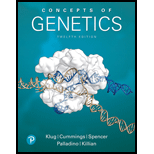
Concepts of Genetics (12th Edition)
12th Edition
ISBN: 9780134604718
Author: William S. Klug, Michael R. Cummings, Charlotte A. Spencer, Michael A. Palladino, Darrell Killian
Publisher: PEARSON
expand_more
expand_more
format_list_bulleted
Textbook Question
Chapter 14, Problem 2CS
A couple with a child affected with DBA undergoes in vitro fertilization (IVF) and genetic testing of the resulting embryos to ensure that the embryos will not have DBA. However, they also want the embryos screened to ensure that the one implanted can serve as a suitable donor for their existing child. Their plan is to have stem cells from the umbilical cord of the new baby transplanted to their existing child with DBA, thereby curing the condition. What are the ethical pros and cons of this situation?
Expert Solution & Answer
Want to see the full answer?
Check out a sample textbook solution
Students have asked these similar questions
State the five functions of Globular Proteins, and give an example of a protein for each function.
Diagram of check cell under low power and high power
a couple in which the father has the a blood type and the mother has the o blood type produce an offspring with the o blood type, how does this happen? how could two functionally O parents produce an offspring that has the a blood type?
Chapter 14 Solutions
Concepts of Genetics (12th Edition)
Ch. 14 - Prob. 1NSTCh. 14 - A series of mutations in the bacterium Salmonella...Ch. 14 - HbS results from the substitution of valine for...Ch. 14 - Given that a faulty ribosomal protein is the...Ch. 14 - A couple with a child affected with DBA undergoes...Ch. 14 - Prob. 3CSCh. 14 - HOW DO WE KNOW? In this chapter, we focused on the...Ch. 14 - CONCEPT QUESTION Review the Chapter Concepts list...Ch. 14 - Contrast the roles of tRNA and mRNA during...Ch. 14 - Francis Crick proposed the adaptor hypothesis for...
Ch. 14 - During translation, what molecule bears the codon?...Ch. 14 - The chain of eukaryotic hemoglobin is composed of...Ch. 14 - Assuming that each nucleotide in an mRNA is 0.34...Ch. 14 - Summarize the steps involved in charging tRNAs...Ch. 14 - To carry out its role, each transfer RNA requires...Ch. 14 - What are isoaccepting tRNAs? Assuming that there...Ch. 14 - When a codon in an mRNA with the sequence 5-UAA-3...Ch. 14 - Discuss the potential difficulties of designing a...Ch. 14 - Prob. 13PDQCh. 14 - Prob. 14PDQCh. 14 - The synthesis of flower pigments is known to be...Ch. 14 - The study of biochemical mutants in organisms such...Ch. 14 - Explain why the one-gene: one-enzyme concept is...Ch. 14 - Why is an alteration of electrophoretic mobility...Ch. 14 - Prob. 19PDQCh. 14 - Prob. 20PDQCh. 14 - Prob. 21PDQCh. 14 - Prob. 22PDQCh. 14 - Several amino acid substitutions in the and ...Ch. 14 - Define and compare the four levels of protein...Ch. 14 - What are the two common types of protein secondary...Ch. 14 - How do covalent disulfide bonds, hydrogen bonds...Ch. 14 - Prob. 27PDQCh. 14 - List three different types of posttranslational...Ch. 14 - Prob. 29PDQCh. 14 - How does an enzyme function? Why are enzymes...Ch. 14 - Prob. 31PDQCh. 14 - Three independently assorting genes (A, B, and C)...Ch. 14 - How would the results vary in cross (a) of Problem...Ch. 14 - Deep in a previously unexplored South American...Ch. 14 - Many antibiotics are effective as drugs to fight...Ch. 14 - The flow of genetic information from DNA to...Ch. 14 - Prob. 37ESP
Knowledge Booster
Learn more about
Need a deep-dive on the concept behind this application? Look no further. Learn more about this topic, biology and related others by exploring similar questions and additional content below.Similar questions
- What is the opening indicated by the pointer? (leaf x.s.) stomate guard cell lenticel intercellular space none of thesearrow_forwardIdentify the indicated tissue? (stem x.s.) parenchyma collenchyma sclerenchyma ○ xylem ○ phloem none of thesearrow_forwardWhere did this structure originate from? (Salix branch root) epidermis cortex endodermis pericycle vascular cylinderarrow_forward
- Identify the indicated tissue. (Tilia stem x.s.) parenchyma collenchyma sclerenchyma xylem phloem none of thesearrow_forwardIdentify the indicated structure. (Cucurbita stem l.s.) pit lenticel stomate tendril none of thesearrow_forwardIdentify the specific cell? (Zebrina leaf peel) vessel element sieve element companion cell tracheid guard cell subsidiary cell none of thesearrow_forward
- What type of cells flank the opening on either side? (leaf x.s.) vessel elements sieve elements companion cells tracheids guard cells none of thesearrow_forwardWhat specific cell is indicated. (Cucurbita stem I.s.) vessel element sieve element O companion cell tracheid guard cell none of thesearrow_forwardWhat specific cell is indicated? (Aristolochia stem x.s.) vessel element sieve element ○ companion cell O O O O O tracheid O guard cell none of thesearrow_forward
- Identify the tissue. parenchyma collenchyma sclerenchyma ○ xylem O phloem O none of thesearrow_forwardPlease answer q3arrow_forwardRespond to the following in a minimum of 175 words: How might CRISPR-Cas 9 be used in research or, eventually, therapeutically in patients? What are some potential ethical issues associated with using this technology? Do the advantages of using this technology outweigh the disadvantages (or vice versa)? Explain your position.arrow_forward
arrow_back_ios
SEE MORE QUESTIONS
arrow_forward_ios
Recommended textbooks for you
 Human Heredity: Principles and Issues (MindTap Co...BiologyISBN:9781305251052Author:Michael CummingsPublisher:Cengage Learning
Human Heredity: Principles and Issues (MindTap Co...BiologyISBN:9781305251052Author:Michael CummingsPublisher:Cengage Learning Principles Of Radiographic Imaging: An Art And A ...Health & NutritionISBN:9781337711067Author:Richard R. Carlton, Arlene M. Adler, Vesna BalacPublisher:Cengage LearningEssentials Health Info Management Principles/Prac...Health & NutritionISBN:9780357191651Author:BowiePublisher:Cengage
Principles Of Radiographic Imaging: An Art And A ...Health & NutritionISBN:9781337711067Author:Richard R. Carlton, Arlene M. Adler, Vesna BalacPublisher:Cengage LearningEssentials Health Info Management Principles/Prac...Health & NutritionISBN:9780357191651Author:BowiePublisher:Cengage

Human Heredity: Principles and Issues (MindTap Co...
Biology
ISBN:9781305251052
Author:Michael Cummings
Publisher:Cengage Learning



Principles Of Radiographic Imaging: An Art And A ...
Health & Nutrition
ISBN:9781337711067
Author:Richard R. Carlton, Arlene M. Adler, Vesna Balac
Publisher:Cengage Learning


Essentials Health Info Management Principles/Prac...
Health & Nutrition
ISBN:9780357191651
Author:Bowie
Publisher:Cengage
The Human Reproductive System; Author: Professor Dave Explains;https://www.youtube.com/watch?v=TucxiIB76bo;License: Standard YouTube License, CC-BY